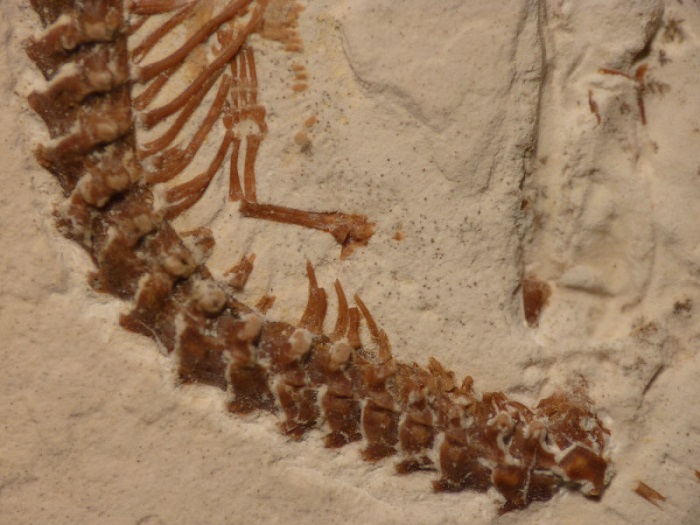We reach more than 65,000 registered users in Dec!! Register Now

Fossils of four legged snake reported found
- September 15, 2015
- 1099 Views
- 0 Likes
- 0 Comment
Scientists say they have discovered the first known fossil of a four-legged snake-sitting in plain view in a museum, where no one had realized its significance before. The object could help reveal how snakes, which evolved from lizards, lost their legs, said the researchers, one of whom called it seemingly "too ...
Scientists say they have discovered the first known fossil of a four-legged snake-sitting in plain view in a museum, where no one had realized its significance before.
The object could help reveal how snakes, which evolved from lizards, lost their legs, said the researchers, one of whom called it seemingly “too good to be true” but real nonetheless.
The findings are described July 23 in the research journal Science.
Researcher Dave Martill from the University of Portsmouth in the U.K. said he found the fossil during a field trip with students to Museum Solnhofen, Germany, which is well known for fossils.
The object “was part of a larger exhibition of fossils from the Cretaceous period,” the last great age of the dinosaurs, he said.
“It was clear that no-one had appreciated its importance, but when I saw it I knew it was an incredibly significant specimen.”
![four-legged-snake[1]](http://machprinciple.com/wp-content/uploads/2015/09/four-legged-snake1.jpg)
“It is a perfect little snake, except it has these little arms and legs, and they have these strange long fingers and toes,” said evolutionary biologist Nick Longrich of the University of Bath in the U.K.
Longrich studied the animal's evolutionary relationships as part of the research effort with Martill, who told him of the find over a pint of beer at a pub in Bath. Longrich said was skeptical-until he saw photographs.
“A four-legged snake seemed fantastic and as an evolutionary biologist, just too good to be true, it was especially interesting that it was put on display in a museum where anyone could see it,” Longrich said.
“It is generally accepted that snakes evolved from lizards,” Martill said. What's unclear, he added, is when, why-and what type of lizard. “This fossil answers some very important questions,” he said. “For example it now seems clear to us that snakes evolved from burrowing lizards, not from marine lizards.”
The fossil, from Brazil, is 110 million years old, making it the oldest definitive snake, Martill and colleagues said. Martill worked with Longrich and German paleontologist Helmut Tischlinger, who prepared and photographed the fossil.
The snake, named Tetrapodophis amplectus by the team, is a juvenile and very small, measuring just 20 cm (8 inches) long, although it may have grown much larger. The head is the size of an adult fingernail, and the smallest tail bone is only a quarter of a millimeter long and there are two sets of legs.
The front legs are very small, about 1 cm long, but have little elbows and wrists and hands measured at just 5 millimeters long. The back legs are slightly longer and the feet are larger than the hands and could have been used to grasp its prey, the scientists said.
“The hands and feet are very specialized for grasping,” Longrich said. “So when snakes stopped walking and started slithering, the legs didn't just become useless little vestiges-they started using them for something else. We're not entirely sure what that would be, but they may have been used for grasping prey, or perhaps mates.”
Interestingly, the researchers said, the fossilized snake also has the remains of its last meal in its guts, including some fragments of bone. The prey was probably a salamander, showing that snakes were carnivorous much earlier than previously believed.
“The preservation of the little snake is absolutely exquisite. The skeleton is fully articulate. Details of the bones are clearly visible and impressions of soft tissues such as scales and the trachea are preserved,” Tischlinger said.
Several features prompted the classification as a snake, rather than a lizard: it has a long body, not a long tail; the tooth implantation, the direction of the teeth, and the pattern of the teeth and the bones of the lower jaw are all snake-like; and there are hints of a single row of belly scales, a sure way to tell a snake from a lizard.
Tetrapodophis would have lived on the bank of a salt lake, in an arid scrub environment, surrounded by succulent plants, the investigators said. It would probably have fed on small amphibians and lizards, trying to avoid the dinosaurs and pterosaurs that lurked.
At the time, South America was joined to Africa as part of a “supercontinent” called Gondwana. The fossil's presence in Gondwana, the scientists said, suggests snakes may have first evolved there, only becoming widespread much more recently.









